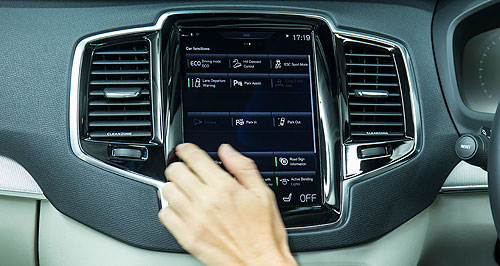News - Market Insight - Market Insight 2015Car owners not using in-vehicle tech: studyDisconnection: Built-in connectivity is among the least-used technologies, with new-car owners typically preferring to use their own smartphone or tablet, according to JD Power. Car-makers are investing heavily into in-car tech that owners are simply not using27 Aug 2015 By TERRY MARTIN GLOBAL car-makers are sinking billions of dollars into in-vehicle technology that many owners are simply not using, according to a new report from JD Power and Associates released this week. In its inaugural Driver Interactive Vehicle Experience (DrIVE) study in the United States, JD Power also identifies dealers as playing a central role in whether or not consumers use the technology – but puts ultimate responsibility back on the car-makers. Analysing driver experiences with in-vehicle technology features during the first 90 days of ownership, the 2015 DrIVE report found that at least 20 per cent of new-vehicle owners had never used 16 of the 33 features measured in the study. The five features owners most commonly reported that they “never use” were: in-vehicle concierge (43 per cent), mobile routers (38 per cent), automatic parking systems (35 per cent), head-up display (33 per cent) and built-in apps (32 per cent). The study found as many as 14 technology features that 20 per cent or more of owners do not want in their next vehicle, with the top six being: rear-seat entertainment (58 per cent), massaging seats (47 per cent), in-vehicle concierge (44 per cent), automatic parking (39 per cent) and, perhaps surprisingly, Android Auto and Apple CarPlay (38 and 37 per cent respectively). Among Gen Y respondents – those born between 1977 and 1994 – the number of features unwanted by at least 20 per cent of owners skyrocketed to 23, specifically technologies related to entertainment and connectivity systems. “In many cases, owners simply prefer to use their smartphone or tablet because it meets their needs they’re familiar with the device and it’s accurate,” said JD Power executive director of driver interaction and HMI research Kristin Kolodge. “In-vehicle connectivity technology that’s not used results in millions of dollars of lost value for both consumers and the manufacturers.” Among all owners, the most frequently cited reasons for not wanting a specific tech feature in their next vehicle were that they “did not find it useful” in their current vehicle and that the technology “came as part of a package on my current vehicle and I did not want it”. Significantly, owners who said their dealer did not explain the feature had a higher likelihood of never using the technology. Furthermore, features that were not activated when the vehicle was delivered often resulted in the owner not even knowing they had the technology onboard. “The first 30 days are critical,” Ms Kolodge said. “That first-time experience with the technology is the make-it-or-break-it stage. “Auto-makers need to get it right the first time, or owners will simply use their own mobile device instead of the in-vehicle technology.” Ms Kolodge said dealerships played the most important role in helping buyers get off to a good start with the technology in their vehicle, given the first few weeks of ownership were critical. However, she said ultimate responsibility came back to the car-makers. “While dealers are expected to play a key role in explaining the technology to consumers, the onus should be on auto-makers to design the technology to be intuitive for consumers,” she said. “Auto-makers also need to explain the technology to dealership staff and train them on how to demonstrate it to owners.” The study, which is based on responses from more than 4200 vehicle owners and lessees (interviewed between April and June this year), found that the technologies that owners most often want are those that enhance the driving experience and safety, which are only available as a built-in feature rather than via an external device. The features most owners do want included were found to be: blind-spot warning and detection (87 per cent), fuel economy indicator (87 per cent), seat lumbar adjustment (86 per cent), phone pairing system (84 per cent) and park assist (82 per cent). Vehicle health diagnostics and adaptive cruise control were also highly rated features.  Read more16th of February 2015  Ford's Sync2 goes onlineMondeo, Falcon, Territory get WiFi connectivity with Ford's next-gen Sync223rd of January 2015  Ford cuts Silicon Valley tech-centre ribbonNew tech-capital innovation centre to accelerate Ford research and development6th of January 2015  Hyundai maps future tech at CESCES hosts Hyundai autonomous driving, new connectivity and control demonstrations16th of December 2014  JLR developing more see-through technologyNew JLR technology seeks to give drivers a full view of their environment31st of October 2014  Lead times lead to frustrationRapid development of smartphones makes cars look second best, says Connexion chief30th of October 2014  Market Insight: Survey uncovers infotainment woesConsumer Reports identifies infotainment as leading source of new car unreliability26th of June 2014  Android coming soon to your car’s dashboard40 car brands commit to Google’s new in-car Android Auto connectivity system |
Click to shareMarket Insight articlesResearch Market Insight Motor industry news |


















Facebook Twitter Instagram